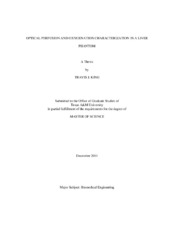| dc.description.abstract | Continuous monitoring of blood perfusion and oxygenation is essential in assessing the health of a transplanted organ. Particularly, monitoring the perfusion and oxygenation of the organ during the two-week period after the transplant procedure is crucial in detecting a sustained loss in perfusion or a reduction in oxygen saturation before these changes render irreversible damage to the organ or patient. Pulse oximetry is a clinically accepted method of monitoring the arterial oxygen saturation of a patient in a non-invasive manner. Pulse oximeters exploit the wavelength-dependent absorption of oxygenated and deoxygenated hemoglobin to measure a patient's arterial oxygen saturation. However, traditional pulse oximeters do not provide perfusion information and produce erroneous oxygen saturation measurements under low perfusion levels.
An optical blood perfusion and oxygenation sensor, based on a modified reflectance pulse oximeter, has been developed for in situ monitoring of transplanted organs. To reduce the number of animal experiments, phantoms that mimic the optical and anatomical properties of liver parenchyma have also been developed. In this work, in vitro data was gathered from dye solutions mimicking oxygenated blood that were pumped through single and multi-layer phantoms mimicking liver parenchyma and through a phantom mimicking the portal vein. A portion of the phantom data was compared to data collected from in vivo occlusion studies performed on female swine to assess the ability of the phantoms to mimic the response observed with changes in blood perfusion through liver parenchyma. Both the single layer and multilayer phantoms showed a similar response to changes in perfusion as the in vivo case. With each phantom, the signal increased linearly with increases in perfusion, but the multilayer phantom showed a higher sensitivity (approximately 30% higher) to changes in perfusion than the single layer phantom. This higher sensitivity would provide the ability to measure smaller changes in perfusion and increase the resolution of the sensor. Also, both parenchymal phantoms showed similar trends in the oxygenation studies, with the R value decreasing with increasing oxygenation. While the observations in this research demonstrate the ability to use both phantoms for in vitro experiments, the results show the multilayer phantom is a better option for mimicking perfusion because it displays similar occlusion patterns as the liver parenchyma in vivo, a higher sensitivity to changes in perfusion than the single layer phantom, and it is only slightly more complex in design (contains only two more layers of sinusoids) than the single layer phantom. | en |


